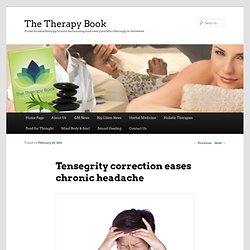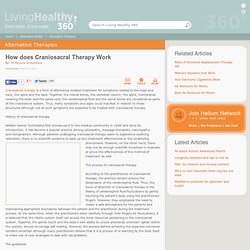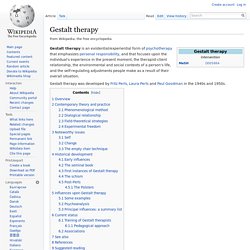

Tensegrity correction eases chronic headache. A woman in her sixties had been consulting me for craniosacral treatment for headaches.

For 20 years she had been suffering from debilitating head pain which had not responded to conventional or complementary approaches, including acupuncture and massage. Her headaches responded to the release of compression in her occipital bone. She experienced almost complete relief by the fourth treatment. Although she was very pleased, I noticed that there was still a degree of hypertonicity in the cervical musculature contributing to some residual discomfort. She mentioned that 30 years previously she had slipped and fallen forward, hitting her sternum on the edge of a step and that she had experienced occasional soreness in that area ever since. This illustrates three things: firstly, patients forget important aspects of their history; secondly, what may seem trivial may be a maintaining factor in a pattern of dysfunction and thirdly, the interconnectedness of the body.
All this for just $7.27. Craniosacral Therapy with Debra Morrice. I expend a lot of effort in my life at the moment.

Not a building-a-pyramid, digging-a-coal-mine kind of effort, you understand. It's not like I'm going to come down with black lung anytime soon. But sometimes transitions (even positive ones like career developments and moving to a new country, in my case), result in effort -- to keep productive, to keep creating, to keep on keepin' on.
Words come to me with ease, and I don't have trouble articulating my quandaries and concerns, to hash out my freak outs. But at a certain point, talking can backfire on me, heightening my anxieties instead of diminishing them. So I seek release in non-verbal ways. And as much as I love yoga, in my toughest times, even that is an effort. In the whimsically emotional Michel Gondry film, Kate Winslet and Jim Carey's characters submit to a quirky treatment to wipe out sad memories holding them back. Here's where Debra Morrice's craniosacral therapy comes in. She laughed and shook her head. Effortlessly. How does craniosacral therapy work? - by Dr Pandula Siribaddana. Dr Pandula Siribaddana's image for: "How does Craniosacral Therapy Work" Caption: Location: Image by: Craniosacral therapy is a form of alternative medical treatment for symptoms related to the head and neck, the spine and the back.

Alexander wiki. The Alexander technique, named after Frederick Matthias Alexander, teaches people how to stop using unnecessary levels of muscular and mental tension during their everyday activities.

It is an educational process rather than a relaxation technique or form of exercise. The Alexander technique has been shown to be helpful for back pain and Parkinson's.[1] There is insufficient evidence to determine if it has any effect in asthma.[2] Practitioners say that such problems are often caused by repeated misuse of the body over a long period of time, for example, by standing or sitting with one's weight unevenly distributed, holding one's head incorrectly, or walking or running inefficiently. Alexander clip. Feldenkrais wiki. Feldenkrais illustrating the function of the human skeleton in sitting.

The Feldenkrais Method, often referred to simply as "Feldenkrais", is a somatic educational system designed by Moshé Feldenkrais (1904–1984). Feldenkrais aims to reduce pain or limitations in movement, to improve physical function, and to promote general wellbeing by increasing students' awareness of themselves and by expanding students' movement repertoire.
Approach[edit] Feldenkrais taught that increasing a person's kinesthetic and proprioceptive self-awareness of functional movement could lead to increased function, reduced pain, and greater ease and pleasure of movement. The Feldenkrais Method, like the Alexander Technique, is therefore a movement pedagogy as opposed to a manipulative therapy. Moshé Feldenkrais (pictured bottom) practising Judo, one of the major influences on his work. Feldenkrais is used to improve movement patterns rather than to treat specific injuries or illnesses. Scientific studies[edit] Feldenkrais clip. Rubenfeld Synergy Method. Rubenfeld Synergy Method. Unergi Body-Psychotherapy with Ute Arnold. Total Clarity Counseling. Cindy Foss Body Psychotherapist, Reiki Master Clinical Member of the United States Association of Body Psychotherapy Co-Founder of The Suppers Programs Body Psychotherapist "In my own practice, I love the experience of facilitating and witnessing others gain self-awareness and self-empowerment as they move through the process of making distinctions and deepening their connections with their mental, emotional, physical and spiritual selves.

" ---Cindy Foss “The Clinical membership is for those who are practicing body psychotherapists and have the following qualifications: […] certification from a recognized body psychotherapy training program and training in formal principles of psychotherapy.” “Eligibility for Clinical membership has two key elements: psychotherapy training and body psychotherapy training.” The Suppers Programs. Gestalt wiki. Gestalt therapy is an existential/experiential form of psychotherapy that emphasizes personal responsibility, and that focuses upon the individual's experience in the present moment, the therapist-client relationship, the environmental and social contexts of a person's life, and the self-regulating adjustments people make as a result of their overall situation.

§Overview[edit] Edwin Nevis described Gestalt therapy as "a conceptual and methodological base from which helping professionals can craft their practice".[1] In the same volume Joel Latner stated that Gestalt therapy is built upon two central ideas: that the most helpful focus of psychotherapy is the experiential present moment, and that everyone is caught in webs of relationships; thus, it is only possible to know ourselves against the background of our relationship to the other.[2] The historical development of Gestalt therapy (described below) discloses the influences that generated these two ideas. §Experimental freedom[edit] Gestalt clip. Melissa Walker, MA, R-DMT.